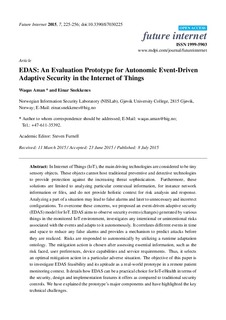| dc.contributor.author | Aman, Waqas | |
| dc.contributor.author | Snekkenes, Einar | |
| dc.date.accessioned | 2017-08-30T07:07:06Z | |
| dc.date.available | 2017-08-30T07:07:06Z | |
| dc.date.created | 2015-07-09T11:13:18Z | |
| dc.date.issued | 2015 | |
| dc.identifier.citation | Future Internet. 2015, 7 (3), 225-256. | nb_NO |
| dc.identifier.issn | 1999-5903 | |
| dc.identifier.uri | http://hdl.handle.net/11250/2452290 | |
| dc.description.abstract | In Internet of Things (IoT), the main driving technologies are considered to be tiny sensory objects. These objects cannot host traditional preventive and detective technologies to provide protection against the increasing threat sophistication. Furthermore, these solutions are limited to analyzing particular contextual information, for instance network information or files, and do not provide holistic context for risk analysis and response. Analyzing a part of a situation may lead to false alarms and later to unnecessary and incorrect configurations. To overcome these concerns, we proposed an event-driven adaptive security (EDAS) model for IoT. EDAS aims to observe security events (changes) generated by various things in the monitored IoT environment, investigates any intentional or unintentional risks associated with the events and adapts to it autonomously. It correlates different events in time and space to reduce any false alarms and provides a mechanism to predict attacks before they are realized. Risks are responded to autonomically by utilizing a runtime adaptation ontology. The mitigation action is chosen after assessing essential information, such as the risk faced, user preferences, device capabilities and service requirements. Thus, it selects an optimal mitigation action in a particular adverse situation. The objective of this paper is to investigate EDAS feasibility and its aptitude as a real-world prototype in a remote patient monitoring context. It details how EDAS can be a practical choice for IoT-eHealth in terms of the security, design and implementation features it offers as compared to traditional security controls. We have explained the prototype’s major components and have highlighted the key technical challenges. | nb_NO |
| dc.language.iso | eng | nb_NO |
| dc.publisher | MDPI | nb_NO |
| dc.relation.uri | http://www.mdpi.com/1999-5903/7/3/225/pdf | |
| dc.rights | Navngivelse 4.0 Internasjonal | * |
| dc.rights.uri | http://creativecommons.org/licenses/by/4.0/deed.no | * |
| dc.title | EDAS: An evaluation prototype for autonomic event-driven adaptive security in the internet of things | nb_NO |
| dc.type | Journal article | nb_NO |
| dc.type | Peer reviewed | nb_NO |
| dc.description.version | publishedVersion | nb_NO |
| dc.source.pagenumber | 225-256 | nb_NO |
| dc.source.volume | 7 | nb_NO |
| dc.source.journal | Future Internet | nb_NO |
| dc.source.issue | 3 | nb_NO |
| dc.identifier.doi | 10.3390/fi7030225 | |
| dc.identifier.cristin | 1253159 | |
| dc.relation.project | Norges forskningsråd: 213131 | nb_NO |
| dc.description.localcode | ©2015 by the authors; licensee MDPI, Basel, Switzerland. This article is an open access article distributed under the terms and conditions of the Creative Commons Attribution license(http://creativecommons.org/licenses/by/4.0/). | nb_NO |
| cristin.unitcode | 194,18,21,80 | |
| cristin.unitname | Norwegian Information Security Lab | |
| cristin.ispublished | true | |
| cristin.fulltext | original | |
| cristin.qualitycode | 1 | |

